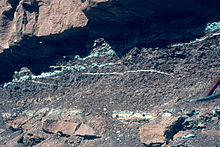Chugwater Formation
| Chugwater Formation (Group) | |
|---|---|
| Stratigraphic range: Triassic | |
 Outcrop of Chugwater Group near Thermopolis, Wyoming | |
| Type | sedimentary |
| Underlies | Nugget Sandstone, Morrison Formation |
| Overlies | Dinwoody Formation, Goose Egg Formation |
| Lithology | |
| Primary | sandstone |
| Other | shale, gypsum, limestone |
| Location | |
| Extent | Wyoming, Colorado, Montana |
| Type section | |
| Named for | Chugwater, Wyoming |
| Named by | N. H. Darton, 1904[1] |

The Chugwater Formation is a mapped bedrock unit consisting primarily of red
Description
The most noticeable feature on a large scale is the brick-red color, caused by
The Chugwater consists mainly of
The main constituent of the Chugwater is
The Chugwater is a prime example of red beds, commonly deposited during the Permian and Triassic periods.
Stratigraphy
The Chugwater Group
For example, in the Wind River and Greater Green River basins, the formations (in ascending stratigraphic order) are: Red Peak Formation, Crow Mountain Formation, Jelm Formation, and Popo Agie Formation.[3] However, in the Powder River Basin, the formations are: Red Peak Formation, Alcova Limestone, Crow Mountain Sandstone, unnamed red beds, and Popo Agie Formation.[4]
Age
Relative age dating of the Chugwater places it in the Triassic Period.
References
- ^ Darton, N.H., 1904, Comparison of the stratigraphy of the Black Hills, Bighorn Mountains, and Rocky Mountain Front Range: Geological Society of America Bulletin, v. 15, p. 379-448. abstract
- ^ Pipiringos, G.N., 1968, Correlation and nomenclature of some Triassic and Jurassic rocks in south-central Wyoming, IN Shorter contributions to general geology, 1967: U.S. Geological Survey Professional Paper, 594-D, p. D1-D26. link to report
- ^ High, L.R., Jr., and Picard, M.D., 1969, Stratigraphic relations within upper Chugwater Group (Triassic), Wyoming: American Association of Petroleum Geologists Bulletin, v. 53, no. 5, p. 1091-1104. abstract
- ^ Cavaroc, V.V., and Flores, R.M., 1991, Red beds of the Triassic Chugwater Group, southwestern Powder River basin, Wyoming, IN Evolution of sedimentary basins; Powder River basin: U.S. Geological Survey Bulletin, 1917-E, p. E1-E17. link to report
